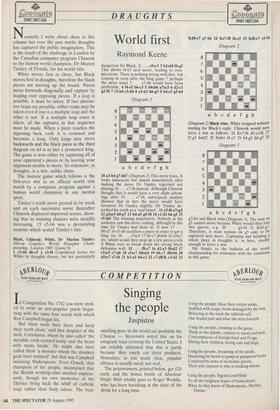DRAUGHTS
World first
Raymond Keene
Normally I write about chess in this column but over the past weeks draughts
has captured the public imagination. This is the result of the challenge in London by the Canadian computer program Chinook to the human world champion, Dr Marion Tinsley of Florida, for his world title. White moves first in chess, but Black moves first in draughts, therefore the black pieces are moving up the board. Pieces move forwards diagonally and capture by leaping over opposing pieces. If a leap is possible, it must be taken. If two alterna- tive leaps are possible, either route may be taken even if one is a multiple leap and the other is not. If a multiple leap route is taken, all the captures in that sequence must be made. When a piece reaches the opposing back. rank it is crowned and becomes a king. Only kings may move backwards and the black piece in the third diagram on h4 is in fact a promoted king. The game is won either by capturing all of your opponent's pieces or by leaving your opponent unable to move. So stalemate, in draughts, is a win, unlike chess. The historic game which follows is the first-ever win in an official world title match by a computer program against a human world champion in any mental sport. Tinsley's tenth move proved to be weak and on each successive move thereafter Chinook displayed improved scores, show- ing that its winning chances were steadily increasing. 15 c5-b6 was a devastating surprise which sealed Tinsley's fate.
Black, Chinook: White, Dr Marion Tinsley: Silicon Graphics World Draughts Cham- pionship. London 1992 (Game 8).
1 c3-d4 d6-e5 2 e3-f4 Considered better for White by draughts theory, but not particularly dangerous for Black. 2 . . . e5xc3 3 h2xd4 f6-g5 This allows f4-e5 next move, leading to com- plications. There is nothing wrong with that, but coming so soon after the long game 7 perhaps the more usual 3 . . . e7-d6 would have been preferable. 4 f4-e5 b6-c5 5 d4xb6 a7xc5 6 d2-c3 g5-f4 7 c3-b4 c5-d4 8 al-b2 h6-g5 9 b4-c5 g5-h4
Diagram I
10 a3-b4 g7-h6? (Diagram 1) This move loses, It looks innocuous but almost immediately after making the move Dr Tinsley regretted not playing 10 . . . e7-f6 instead. Although Chinook thought that it would have a very slight advan- tage after 10 . . . e7-f6, subsequent .analysis showed that in fact the move would have favoured Dr Tinsley slightly. Dr Tinsley de- scribed his tenth as a 'real boner'. 11 e5-f6 e7xg5 12 g3xe5 h8-g7 13 b4-a5 g5-f4 14 el-d2 h6-g5 15 c5-b6! The winning manoeuvre. Nobody in the audience saw this move coming, although by this time Dr Tinsley had done so. If now 15 . . b8-a7 16 e5-d6 sacrifices a piece in order to get a king, viz: 16 . . . c7xe5 17 b6-c7 d8xb6 18 a5xc7 etc, which would then mop up a few. pieces even if White tries to break down the strong black defensive wall. 15 . . . f8-e7 16 d2-e3 f4xd2 17 clxc5 c7-d6 18 e5xc7 bSxb4 19 b6-c7 d8xb6 20 a5xc7 e7-f6 21 b2-a3 b4-c3 22 c7-d8/K c3-d2 23
Kd8-e7 g7-h6 24 Ke7-f8 f6-e5 25 Kf8-e7 e5-f4 Diagram 2
(Diagram 2) Black wins. White resigned without waiting for Black's reply. Chinook would now force a win as follows: 26 Ke7-f6 d2-el/K 27 f2-g3 h4xf2 28 f6xh4 f4-e3 29 h4-g3 h6-g5 30
Diagram 3
g3-h4 and Black wins (Diagram 3). The man on g5 cannot move because White would then lose two pieces, e.g. 30 . . . g5-f4 31 Kh4-g3. Therefore, it must remain on g5 only to be captured next move. Capturing and keeping a whole piece in draughts is, as here, usually enough to force a win. My thanks to the bulletin of the world championship for assistance with the variations in this game.


















































 Previous page
Previous page